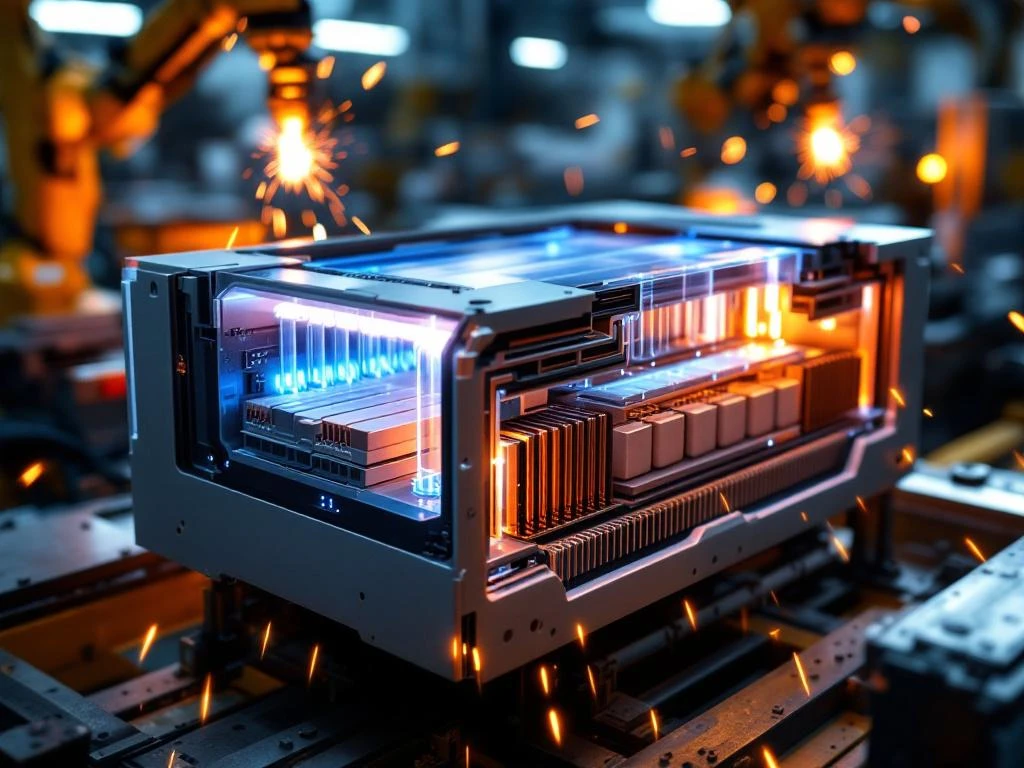When you’re pushing the limits on the track or retrofitting a high-performance sports car, your electric vehicle battery isn’t just a power source—it’s a critical safety component that can make the difference between victory and disaster. Racing environments demand exceptional reliability from every system, and battery failures at high speeds or during intense competition can have catastrophic consequences.
The unique demands of Formula racing and high-performance applications create extreme conditions that standard automotive batteries simply aren’t designed to handle. From rapid acceleration and deceleration cycles to elevated operating temperatures and constant vibration, your electric vehicle battery safety systems must perform flawlessly under pressure.
Understanding the essential safety features for your custom modular energy storage system isn’t just about compliance—it’s about ensuring your investment in cutting-edge technology delivers consistent performance when every millisecond counts.
1. Battery management system with real-time monitoring
A sophisticated battery management system serves as the brain of your electric vehicle battery safety infrastructure. This advanced technology continuously tracks cell voltage, current, and temperature across every module in your custom battery solutions, providing instant feedback on system health and performance.
For racing applications, real-time monitoring becomes even more critical as conditions change rapidly during competition. The BMS must detect anomalies within milliseconds and respond accordingly, whether that means adjusting charging parameters or triggering protective shutdowns. Modern systems can process thousands of data points per second, ensuring your battery pack operates within safe parameters even during the most demanding manoeuvres.
The integration capabilities of advanced BMS technology allow seamless communication with your vehicle’s control systems, providing drivers and pit crews with vital information about battery status throughout the race. This level of monitoring ensures optimal performance whilst maintaining the highest safety standards required for professional motorsport applications.
2. Thermal runaway protection mechanisms
Thermal runaway represents one of the most serious risks in high-performance battery applications, where cells can rapidly overheat and create dangerous chain reactions. Effective protection mechanisms include sophisticated temperature sensors distributed throughout the battery pack design, capable of detecting temperature variations as small as one degree Celsius.
Advanced thermal management systems incorporate multiple layers of protection, from individual cell monitoring to pack-level thermal barriers that prevent heat propagation between modules. These systems utilise automatic shutdown protocols that can isolate affected sections whilst maintaining power to unaffected areas, crucial for safely completing a race or reaching a service area.
Heat dissipation systems work in conjunction with temperature monitoring to actively remove excess heat before it reaches critical levels. This proactive approach is essential in racing environments where ambient temperatures can exceed 40°C and battery cells face continuous high-current demands that generate substantial internal heat.
3. Overcurrent and short circuit protection
Electrical protection systems form the first line of defence against catastrophic failures in high-performance applications. Modern EV battery protection incorporates multiple tiers of current limiting devices, including ultra-fast acting fuses, electronic circuit breakers, and intelligent current monitoring systems that can respond to fault conditions within microseconds.
The extreme current demands of racing applications require protection systems that can distinguish between normal high-current operation and dangerous fault conditions. Advanced systems utilise smart algorithms that analyse current patterns and can differentiate between expected power spikes during acceleration and genuine electrical faults that require immediate intervention.
Redundant protection ensures that even if primary systems fail, backup mechanisms will prevent damage to your expensive battery investment. This multi-layered approach is particularly important in custom modular systems where individual modules must be protected whilst maintaining overall system functionality.
4. Voltage regulation and overvoltage protection
Precise voltage control becomes critical when dealing with high-performance battery systems that operate at elevated power levels. Voltage monitoring systems continuously track each cell and module, ensuring that charging and discharging operations remain within safe parameters even during rapid power fluctuations common in racing scenarios.
Protection circuits automatically intervene when voltage levels approach dangerous thresholds, preventing cell damage that could compromise performance or safety. These systems must be calibrated specifically for racing applications where voltage demands can change dramatically within seconds, requiring extremely responsive protection mechanisms.
Advanced voltage regulation also contributes to consistent performance by maintaining optimal operating conditions across all battery cells. This uniformity is essential for extracting maximum performance from your modular battery systems whilst ensuring longevity and reliability throughout the racing season.
5. Advanced cooling systems for temperature control
Effective thermal management separates professional-grade battery systems from standard automotive applications. High-performance battery cooling systems utilise both air-cooled and liquid-cooled solutions, often in combination, to maintain optimal operating temperatures even in extreme conditions up to 50°C ambient temperature.
Liquid cooling systems offer superior heat removal capacity, essential for racing applications where battery cells face continuous high-current demands. These systems circulate coolant through dedicated channels within the battery pack, providing precise temperature control that maintains cell performance whilst preventing thermal damage.
The integration of cooling systems with overall vehicle thermal management ensures optimal performance without compromising other critical systems. Advanced designs incorporate variable-speed pumps and fans that adjust cooling capacity based on real-time temperature data, maximising efficiency whilst minimising parasitic power losses that could affect race performance.
6. Fire suppression and containment systems
Fire protection in high-performance battery applications requires sophisticated detection and suppression capabilities that go far beyond standard automotive requirements. Advanced systems incorporate multiple detection methods, including thermal sensors, smoke detectors, and gas analysers that can identify potential fire conditions before visible signs appear.
Containment systems utilise fire-resistant materials and compartmentalisation to prevent fire spread between battery modules. This design approach ensures that even if one section experiences thermal issues, the remainder of the system remains protected and potentially operational, crucial for safely completing a race or reaching emergency services.
Automatic suppression systems can deploy fire-retardant materials or inert gases to extinguish fires whilst minimising damage to surrounding components. These systems must be carefully designed to avoid creating additional hazards, such as toxic gases in enclosed cockpit environments common in racing applications.
7. Impact and vibration resistance design
Racing environments subject battery systems to extreme mechanical stresses that would quickly destroy standard automotive batteries. Professional-grade systems incorporate reinforced housings manufactured from high-strength materials capable of withstanding significant impacts whilst maintaining structural integrity.
Vibration dampening systems protect sensitive internal components from the constant mechanical stress of high-performance driving. These systems utilise advanced materials and mounting techniques that absorb and dissipate vibrational energy, preventing fatigue damage that could compromise safety or performance over time.
The structural design must balance protection with weight considerations critical in racing applications. Advanced engineering techniques allow maximum protection whilst minimising added mass, ensuring your custom battery solutions deliver optimal performance without compromising vehicle dynamics.
8. Insulation monitoring and ground fault detection
Electrical insulation systems prevent dangerous current leakage that could create shock hazards or system failures. Continuous insulation monitoring utilises sophisticated measurement techniques to detect degradation before it reaches dangerous levels, providing early warning of potential problems.
Ground fault detection systems immediately identify any unintended electrical paths that could compromise safety or performance. These systems are particularly important in racing environments where vibration, temperature extremes, and mechanical stress can gradually degrade insulation materials over time.
Advanced monitoring systems provide detailed diagnostic information that helps maintenance teams identify and address insulation issues during routine service intervals, preventing unexpected failures during competition when safety and performance are paramount.
9. Emergency disconnect and isolation systems
Rapid battery isolation capabilities are essential for emergency response and routine maintenance in professional racing environments. Manual disconnect systems provide immediate battery isolation accessible to drivers, crew members, and emergency responders, even when electronic systems have failed.
Automatic isolation systems can respond to fault conditions faster than human reaction times, immediately disconnecting battery power when dangerous conditions are detected. These systems utilise multiple redundant triggers to ensure reliable operation even when primary control systems are compromised.
The design of disconnect systems must consider accessibility during emergency situations whilst preventing accidental activation during normal operation. Professional systems incorporate clear visual indicators and standardised procedures that allow rapid response by trained personnel in high-stress situations.
10. Cell balancing for uniform performance
Maintaining uniform charge distribution across all battery cells is crucial for both safety and performance in demanding applications. Active cell balancing systems continuously monitor and adjust individual cell voltages, preventing dangerous imbalances that could lead to overcharging or thermal issues.
Advanced balancing algorithms optimise the process for racing applications where rapid charging and discharging cycles can quickly create imbalances between cells. These systems work continuously during operation, ensuring consistent performance throughout extended racing sessions or practice periods.
The sophistication of modern balancing systems allows them to compensate for minor cell variations that naturally occur over time, extending battery life whilst maintaining the uniform performance essential for competitive racing applications.
11. Pressure relief and venting mechanisms
Controlled pressure management prevents dangerous gas buildup within battery enclosures that could lead to explosive conditions. Pressure relief valves are calibrated to activate at specific thresholds, safely releasing gases whilst preventing contamination from entering the battery compartment.
Venting systems must be designed to direct released gases away from vehicle occupants and ignition sources, particularly important in racing applications where hot exhaust components and electrical systems create potential ignition hazards. Strategic placement and ducting ensure safe gas disposal even during high-speed operation.
Advanced systems incorporate filtration and neutralisation capabilities that process released gases before venting, reducing environmental impact whilst maintaining safety. These features are increasingly important as racing organisations implement stricter environmental standards for competition vehicles.
12. Communication protocols for system safety
Robust communication networks enable real-time safety data exchange between battery systems and vehicle control units. CAN bus, Modbus, and other industrial-grade protocols provide reliable data transmission even in the electrically noisy environment of high-performance racing vehicles.
Advanced communication systems allow integration with telemetry networks that provide pit crews with real-time battery status information during competition. This capability enables proactive management of battery systems and early identification of developing issues that could affect performance or safety.
Redundant communication pathways ensure continued operation even if primary networks fail, maintaining critical safety functions when electronic systems face the extreme conditions common in professional motorsport applications.
13. Environmental sealing and ingress protection
Professional-grade battery systems require robust environmental protection that exceeds standard automotive requirements. IP67 or higher ratings ensure complete protection against water ingress and dust contamination, essential for systems that may face extreme weather conditions during outdoor racing events.
Sealing technologies must maintain their effectiveness despite temperature cycling, vibration, and mechanical stress that could compromise standard automotive seals. Advanced materials and design techniques ensure long-term protection without requiring frequent maintenance that could disrupt racing schedules.
Environmental protection extends beyond water and dust to include chemical resistance against fuels, lubricants, and cleaning solvents commonly encountered in racing environments. This comprehensive protection ensures reliable operation regardless of operating conditions or maintenance procedures.
14. Redundant safety systems and fail-safes
Multiple backup mechanisms ensure continued protection even when primary safety features experience failures. Redundant systems utilise independent sensors, control circuits, and power supplies that can maintain critical safety functions regardless of individual component failures.
Fail-safe design principles ensure that system failures result in safe operating modes rather than dangerous conditions. This approach is particularly important in racing applications where component failures must not compromise driver safety or create hazards for other competitors.
Advanced diagnostics continuously monitor the health of safety systems themselves, providing early warning when backup systems are needed or when maintenance is required to restore full redundancy. This proactive approach ensures maximum safety throughout the racing season.
15. Compliance monitoring and diagnostic capabilities
Comprehensive diagnostic systems continuously monitor safety compliance and log events for analysis and maintenance planning. These systems track performance trends that indicate developing issues, enabling proactive maintenance that prevents failures during critical competition periods.
Event logging capabilities provide detailed records of system operation that can be analysed to optimise performance and identify potential improvements. This data proves invaluable for developing racing strategies and ensuring consistent performance throughout extended competition seasons.
Automated reporting systems can alert maintenance teams to developing issues and schedule required service intervals, ensuring your battery safety features remain at peak effectiveness when performance and safety are most critical.
Building your ultimate safety-focused battery system
Creating a comprehensive safety system for high-performance electric vehicle applications requires careful integration of all these essential features. The key lies in understanding how each component works together to create a robust, reliable system that can handle the extreme demands of professional racing whilst maintaining the highest safety standards.
The investment in proper safety systems pays dividends through reduced maintenance costs, improved reliability, and the peace of mind that comes from knowing your battery system can handle whatever challenges the track presents. Whether you’re developing a new racing programme or upgrading existing systems, these safety features form the foundation of any successful high-performance electric vehicle project.
Implementing these advanced safety features requires expertise in both battery technology and racing applications. If you’re ready to discuss how these essential safety systems can be integrated into your specific racing or high-performance application, we’d be delighted to help you develop the perfect solution. Contact us to explore how our custom modular energy storage systems can deliver the performance and safety your application demands.


